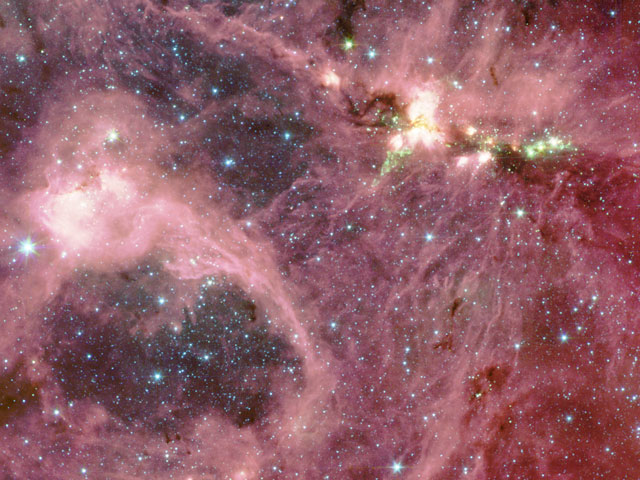
|
Explanation: Deep in the normally hidden recesses of giant molecular cloud DR21, a stellar nursery has been found creating some of the most massive stars yet recorded. The orbiting Spitzer Space Telescope's Infrared Array Camera opened the window into the cloud last year in mid- infrared light. The cloud is opaque to visible light because of dense interstellar dust. Noticeable in the above representative color infrared Spitzer image are huge bubbles, a complex tapestry of dust and gas, and very massive stars. The infrared filaments actually glow because of organic compounds known as PAHs. The intricate patterns are caused by complex interactions between interstellar winds, radiation pressures, magnetic fields, and gravity. The pictured region spans about 75 light years and lies about 6,000 light years distant toward the constellation of Cygnus.
|
January February March April May June July August September October November December |
| ||||||||||||||||||||||||||||||||||||||||||||||||
NASA Web Site Statements, Warnings, and Disclaimers
NASA Official: Jay Norris. Specific rights apply.
A service of: LHEA at NASA / GSFC
& Michigan Tech. U.
Based on Astronomy Picture
Of the Day
Publications with keywords: star formation - stellar nursery
Publications with words: star formation - stellar nursery
See also:
- APOD: 2025 December 9 B The Heart of the Soul Nebula
- APOD: 2025 July 10 B Lynds Dark Nebula 1251
- APOD: 2025 June 23 B W5: Pillars of Star Formation
- APOD: 2025 April 28 B Gum 37 and the Southern Tadpoles
- APOD: 2025 March 26 B Star Formation in the Pacman Nebula
- APOD: 2024 October 22 B M16: Pillars of Star Creation
- Star Factory Messier 17
